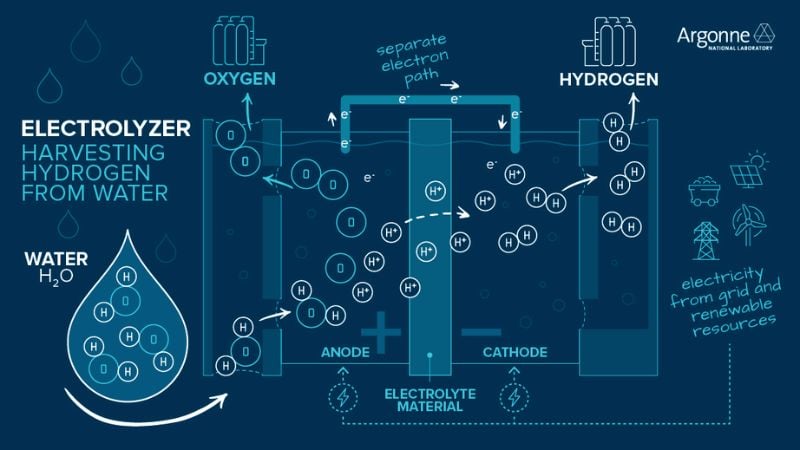The Challenges of Transitioning to Hydrogen Power Plants
Green hydrogen is promising as an emissions-free power solution within renewable frameworks. However, scientists from the Reiner Lemoine Institute point out several challenges in transitioning to 100 percent hydrogen power plants.
In the evolving energy landscape, thermal power plants could be crucial to ensure a consistent energy supply. Their significance becomes pronounced when renewable energy sources face limitations in generating adequate electricity for extended periods. To enhance the energy system's resilience, myriad strategies to diversify and strengthen supply options are being explored.
Hydrogen power. Image used courtesy of Los Alamos National Laboratory
One option for emission-free power plants is green hydrogen. Hydrogen (H2) is significant within the renewable energy framework, ensuring stable electricity generation. However, new and current power plants need to become H2-ready as they are adapted for H2 utilization, a process challenged by a lack of definition for what constitutes “H2-readiness.”
Researchers at the Reiner Lemoine Institute (RLI) in Berlin, Germany, have published a recent study outlining methodologies to establish regulatory definitions for H2 readiness across the European Union. Their findings also suggest the challenges of transitioning to hydrogen adoption in power generation.
Defining H2-Ready
Hydrogen power may be a secure complement to safeguard against supply and demand imbalances that sometimes result from using energy generated by renewable sources such as wind and solar. However, the commercial availability of gas turbines to support 100 percent hydrogen use in larger plants is not yet viable. Thus, the construction or retrofitting of H2-ready power plants is an attempt to pave the way with the support of political and financial incentives.
Although “H2-ready” is a term within European legislation for power plants, its precise definition remains ambiguous. This complicates the planning process for these plants. A well-defined concept for H2 readiness can establish a dependable framework for bringing emission-free H2 power plants to fruition.
Categories of power plant types in the power plant strategy. Image used courtesy of the Reiner Lemoine Institute
Up to this point, Germany has the only known implicit definition found in the Combined Heat and Power Act. According to this definition, the shift to utilizing 100 percent hydrogen should be feasible while costing less than 10 percent of the power plant's initial investment. This definition aims to prioritize substantial emissions reduction as the primary focus.
This definition favors investments in more efficient but expensive combined-cycle gas and steam power plants. However, these run for many hours and require a higher demand for hydrogen.
Cost and Supply Challenges
While hydrogen power plants present a solution, the unfortunate truth is that sustainable (or green) hydrogen is complex and costly to produce.
Green hydrogen is produced through electrolysis that uses renewable energy sources, while grey or blue hydrogen is created using fossil fuels with carbon capture technology. Using blue hydrogen in hydrogen power plants can lead to emissions comparable to or higher than those generated by natural gas.
Hydrogen electrolysis process. Image used courtesy of Argonne National Laboratory
Utilizing green hydrogen in energy infrastructure is crucial for a successful energy transition.
A 400 MW power plant running on 100 percent hydrogen will use more than 700 MWh per hour. This is equivalent to 12 fourteen-wheeler trucks’ worth of hydrogen.
Obtaining the required volume of green hydrogen is necessary to achieve successful decarbonization, and this is a significant challenge. The RLI researchers say the key lies in linking the hydrogen power plants to the hydrogen core network and ensuring a consistent supply of green hydrogen.
Establishing the infrastructure required for large-scale green hydrogen production and distribution is a significant hurdle. It involves building electrolyzers, renewable energy farms, storage facilities, and distribution networks, all of which demand substantial investments and time.
Additionally, the RLI team concluded that the most extensive retrofitting measures primarily involve the fuel gas and gas turbine systems. The anticipated costs for these modifications are expected to be under 10 percent of the initial investment for larger combined cycle power plants. However, these retrofitting expenses are likely to be considerably higher for gas turbine plants.
New H2-ready gas-fired power plants are being constructed with a requirement to transition to 100 percent hydrogen operation by 2035. Using gas turbines with pure hydrogen is currently in its pilot phase. It will take several more years for this technology to become firmly established.









